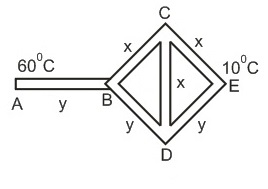Q.
Three rods of material $x$ and three rods of material $y$ of identical length and cross sectional area are connected as shown in the figure. If the end $A$ is maintained at $60^{\circ} C$ and the junction $E$ at $10^{\circ} C$, then the temperature of junction $C$ is [Given the thermal conductivity of $x$ is $0.92\, W / m . K$ and that of $y$ is $0.46 \,W / m . K$ ]

NTA AbhyasNTA Abhyas 2022
Solution: